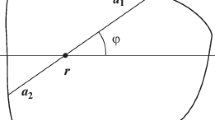Abstract
We study a model of wireless networks where users move at speed \(\theta \ge 0\), which has the original feature of being defined through a fixed-point equation. Namely, we start from a two-class processor-sharing queue to model one representative cell of this network: class 1 users are patient (non-moving) and class 2 users are impatient (moving). This model has five parameters, and we study the case where one of these parameters is set as a function of the other four through a fixed-point equation. This fixed-point equation captures the fact that the considered cell is in balance with the rest of the network. This modeling approach allows us to alleviate some drawbacks of earlier models of mobile networks. Our main and surprising finding is that for this model, mobility drastically improves the heavy traffic behavior, going from the usual \(\frac{1}{1-\varrho }\) scaling without mobility (i.e., when \(\theta = 0\)) to a logarithmic scaling \(\log (1/(1-\varrho ))\) as soon as \(\theta > 0\). In the high load regime, this confirms that the performance of mobile systems benefits from the spatial mobility of users. Finally, other model extensions and complementary methodological approaches to this heavy traffic analysis are discussed.

Similar content being viewed by others
References
Anton, E., Ayesta, U., Simatos, F.: On the impact of mobility in cellular networks. In: WiOpt 19: Modeling and Optimization in Mobile, Ad-Hoc and Wireless Networks (2019)
Baynat, B., Indre, R.-M., Nya, N., Olivier, P., Simonian, A.: Impact of mobility in dense LTE-A networks with small cells. In: IEEE 81st Vehicular Technology Conference (VTC Spring), pp. 1–5 (2015)
Bonald, T., Borst, S.C., Proutiere, A: How mobility impacts the flow-level performance of wireless data systems. In: Proc. INFOCOM ’04, vol. 3, pp. 1872–1881 (2004)
Bonald, T., Proutiere, A.: Wireless downlink data channels: user performance and cell dimensioning. MobilCom’03, pp. 339–352 (2003)
Bonald, T., Borst, S., Hegde, N., Jonckheere, M., Proutiere, A.: Flow-level performance and capacity of wireless networks with user mobility. Queueing Syst. 63(1–4), 131–164 (2009)
Borst, S.C., Hegde, N., Proutiere, A.: Mobility-driven scheduling in wireless networks. In: Proc. IEEE INFOCOM ’09, pp. 1260–1268 (2009)
Borst, S., Proutiere, A., Hegde, N.: Capacity of wireless data networks with intra- and inter-cell mobility. In: Proc. IEEE INFOCOM ’06, pp. 58–1069 (006)
Borst, S., Simatos, F.: A stochastic network with mobile users in heavy traffic. Queueing Syst. 74(1), 1–40 (2013)
Freidlin, M.I.: The averaging principle and theorems on large deviations. Russ. Math. Surv. 33(5), 117–176 (1978)
Grossglauser, M., Tse, D. Mobility increases the capacity of ad-hoc wireless networks. In:Proc. IEEE INFOCOM ’01, vol. 3, pp. 60–1369 (2001)
Hajek, B.: Hitting-time and occupation-time bounds implied by drift analysis with applications. Adv. Appl. Probab. 14(3), 502–525 (1982)
Huang, G., Mandjes, M., Spreij, P.: Large deviations for Markov-modulated diffusion processes with rapid switching. Stoch. Process. Appl. 126(6), 1785–1818 (2016)
Knessl, C., Matkowsky, B.J., Schuss, Z., Tier, C.: On the performance of state-dependent single server queues. SIAM J. Appl. Math. 46(4), 657–697 (1986)
Knessl, C., Tier, C.: Applications of singular perturbation methods in queueing, In: Advances in Queueing Theory, Methods and Open Problems, Probability and Stochastics Series, pp. 311–336. CRC Press (1995)
Lin, M., Wierman, A., Zwart, B.: The average response time in a heavy-traffic SRPT queue. SIGMETRICS Perform. Eval. Rev. 38(2), 12–14 (2010)
Liptser, Robert: Large deviations for two scaled diffusions. Probab. Theory Relat. Fields 106(1), 71–104 (1996)
Ma, H., Zhao, D., Yuan, P.: Opportunities in mobile crowd sensing. IEEE Commun. Mag. 52(8), 29–35 (2014)
Olivier, P., Simonian, A., Simatos, F.: Performance analysis ofdata traffic in small cells networks with user mobility. In: Puliafio, A., Trivedi, K.S. (eds.) Systems Modeling: Methodologies and Tools, EAI/Springer Innovations in Communicationand Computing, pp. 177–193. Springer, Cham (2019)
Puhalskii, A.A.: On large deviations of coupled diffusions with time scale separation. Ann. Probab. 44(4), 3111–3186 (2016)
Rege, K.M., Sengupta, B.: Queue-length distribution for the discriminatory Processor-Sharing queue. Oper. Res. 44(4), 653–657 (1996)
Robert, P.: Stochastic networks and queues. Stochastic modelling and applied probability series, p. xvii+398. Springer, New York (2003)
Schuss, Z.: Theory and Applications of Stochastic Processes, An analytical Approach, Applied Mathematical Sciences Series, vol. 170. Springer (2010)
Simatos, F., Tibi, D.: Spatial homogenization in a stochastic network with mobility. Ann. Appl. Probab. 20(1), 312–355 (2010)
Simonian, A., Olivier, P.: Performance of data traffic in small cells networks with inter-cell mobility. In: Proceedings of 10th EAI International Conference on Performance Evaluation Methodologies and Tools. ACM (2017). https://doi.org/10.4108/eai.25-10-2016.2266520
Simatos, F., Simonian, A.: Heavy load analysis of the multi-class Processor-Sharing queue with impatience, In preparation
Veretennikov, AYu.: On large deviations in the averaging principle for SDEs with a “full dependence”. Ann. Probab. 27(1), 284–296 (1999)
Veretennikov, AYu.: On large deviations in the averaging principle for SDE’s with a “full dependence”, revisited. Discrete Contin. Dyn. Syst. Ser. B 18(2), 523–549 (2013)
Yin, G.G., Zhang, A.: Continuous-Time Markov Chains and Applications. A two-time scale approach. Stochastic Modelling and Applied Probability Series. Springer, New York (2013)
Author information
Authors and Affiliations
Corresponding author
Additional information
Publisher's Note
Springer Nature remains neutral with regard to jurisdictional claims in published maps and institutional affiliations.
Rights and permissions
About this article
Cite this article
Simatos, F., Simonian, A. Mobility can drastically improve the heavy traffic performance from \(\frac{1}{1-\varrho }\) to \(\log (1/(1-\varrho ))\). Queueing Syst 95, 1–28 (2020). https://doi.org/10.1007/s11134-020-09652-0
Received:
Revised:
Published:
Issue Date:
DOI: https://doi.org/10.1007/s11134-020-09652-0




